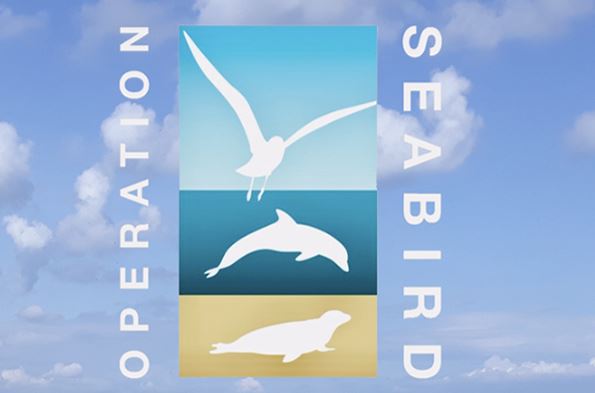The launch of this year’s Operation Seabird took place this week along the Greater Lincolnshire coastline.
Saltfleet – just down the coast from Cleethorpes and Tetney – and Barton’s Far Ings NNR – hosted organisations from across across the region to raise awareness of our spectacular wildlife.
The Humber Nature Partnership supported the day of action, as the coastline prepares for the Easter break.
Police patrols looked for disturbance and antisocial behaviour – offering advice to visitors about how they can minimise their impact on our coastal wildlife along the Humber Estuary European Marine Site.
Regarded as one of the most important estuaries in Europe for its wildlife and habitats, the Humber Estuary European Marine Site covers the entire Humber Estuary and spans the North Sea from the Spurn Peninsula to north Mablethorpe.
During the spring and summer months, the reedbeds and shingle on the beaches support elusive and sometimes rare species such as Bittern, Marsh Harrier and Little Tern during their breeding season.
Over the autumn and winter months, the land and skies around the Humber Estuary fill with migrating birds such as Pink-Footed Geese, with the rich and fertile habitat providing a welcome food source after their long journey from Scandinavia, Iceland and beyond.
Humber Nature Partnership (which includes local authorities along the Humber and Lincolnshire Coast, Natural England, Environment Agency, RSPB, Yorkshire Wildlife Trust, Lincolnshire Wildlife Trust and many other stakeholders) unfortunately received 190 reports of wildlife disturbance from members of the public during 2022.
Many of these incidents were likely by people who did not know they were causing an issue such as impacting breeding success or overall health of these legally protected species and habitats. Operation Seabird aims to engage with and educate members of the public on issues around wildlife disturbance.
Chief Inspector Derek Hussain who is the lead for Rural Crime in Humberside Police said: “Our dedicated Rural Task Force has to deal with a number of reports each year of members of the public on the water, approaching too closely to the wildlife that lives in the area. This includes nesting seabirds and marine mammals.
“The key focus of Operation Seabird is to ensure that members of the public using the waters along the Yorkshire coast and Humber Estuary do so in a responsible way. We want to ensure they keep their distance from the wildlife to prevent intentional disturbance and to safeguard this stretch of coastline, allowing future generations to enjoy the spectacle we see today.”
DC Aaron Flint, Force Wildlife Crime Officer for Lincolnshire Police said: “The Lincolnshire coastline is a very important feature of our amazing county, providing habitat for wildflowers, insects, reptiles, birds and mammals. It also attracts many visitors each year. Unfortunately, each year we receive a large number of reports relating to members of the public disturbing wildlife such as nesting birds or resting seals, damaging the features of our SSSI’s either on foot, using motor bikes/ off road vehicles or airborne vehicles such as paramotors.
“The focus of Operation Seabird is to protect our important coastline whilst also allowing members of the public enjoy it responsibly, this is done mainly through educating the public regarding the need to keep their distance from wildlife to prevent disturbance, stay on footpaths and public areas and not to drive motor vehicles on the sites to prevent destruction of SSSI features. It’s important to note that although education is the main focus of the operation enforcement action and prosecutions will be taken where necessary.”
Jackson Sage, Project Manager for the Humber Management Scheme at Humber Nature Partnership said: “The Humber Estuary is home to up to 140,000 breeding and migratory birds, marine mammals such as seals and Harbour Porpoise, all supported by tens of thousands of hectares of delicate habitats protected under UK law. We want people to enjoy the beautiful landscapes and wildlife we have on our doorstep, but do so in a way that does not come at the expense of the important species and habitats that we are so lucky to have.”
Geoff Edmond, RSPCA National Wildlife Coordinator said: “Operation Seabird is being launched for 2023 building on the success it has achieved with many organisations working together to support the Police and RSPCA in partnership to encourage people to enjoy the wonderful marine wildlife we have on our coastline and to keep a safe distance to avoid any disturbance. I welcome the opportunity for the RSPCA to work alongside the Humber Nature Partnership and the Police”.
More information about how to responsibly enjoy our great outdoors can be found on Countryside Code (https://www.gov.uk/government/publications/the-countryside-code/the-countryside-code-advice-for-countryside-visitors) or the Yorkshire Marine Nature Partnership website (https://ymnp.org.uk/discover/caring-for-our-coast/)

Operation Seabird: Questions & Answers
What is Operation Seabird?
Operation Seabird is a multi-agency operation between the Police, RSPCA and other authorities and organisations designed to address wildlife disturbance on our coastline.
Operation Seabird aims to engage with and educate members of the public of the amazing wildlife we have on our coastline, and how to avoid disturbing these legally protected species and habitats. Although the aim is primarily to educate and engage with the public, the Police and government bodies that are part of the Operation can use their enforcement powers should they be required.
Operation Seabird has numerous “Days of Action” throughout the year, with Tuesday 4th April being the launch of the 2023 season.
Why is the Humber Estuary important for wildlife?
The Humber Estuary has a number of environmental designations due to it’s special habitats and species. It is designated as a:
- Site of Special Scientific Interest (SSSI)
- Special Protection Area (SPA)
- Special Area of Conservation (SAC)
- Site of International Importance under the Ramsar convention.
These designations form the Humber Estuary European Marine Site which covers and stretches from Goole and Scunthorpe in the west, to Spurn and north Mablethorpe in the east.
Spring/Summer on the Humber brings important species of breeding bird such as Marsh Harrier, Bittern and Little Tern.
Autumn/Winter see’s the bird population swell to 150,000+ birds, some travelling thousands of miles from the high Arctic such as Brent Geese and Pink-Footed Geese. Autumn/Winter is also an important time for our protected Grey Seal colonies on the Humber where around 2,200 pups are born each year.
The habitats that support these species are also protected under UK Law, such as the sand-dunes, saltmarsh and mudflats.
What is wildlife disturbance?
Recreational disturbance is when leisure activity causes:
- Significant change in wildlife behaviour (e.g. taking flight/leaving nest due to fright, calling out in alarm, no longer feeding).
- Damage or destruction to habitat (e.g. trampling of saltmarsh/sand dunes/sea grass)
- Physical harm or death to wildlife.
How many reports of wildlife disturbance were there last year?
Humber Nature Partnership received 190 reports of disturbance last year across 24 different locations. The most common activities that were reported were:
- Off-roading
- Dog’s off lead
- Walking too close to protected species
How do you report a wildlife disturbance?
Issues can be reported to the Police on 101 by quoting “Operation Seabird”. Humber Nature Partnerships reporting form can be found on their website at www.humbernature.co.uk

Share this article